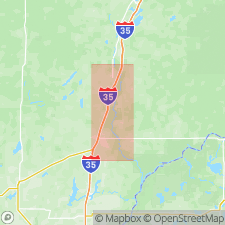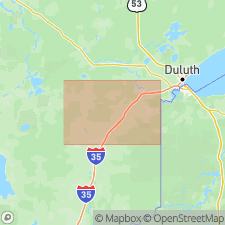
- Usage in publication:
-
- Hinckley sandrock
- Modifications:
-
- [Incidental mention]
- AAPG geologic province:
-
- Sioux uplift
Summary:
Pg. 336-337. Hinckley sandrock (Potsdam?) is separated from overlying Dresbach sandrock by shales [which he both included and excluded from his St. Croix, and which he in 1888 named Dresbach shale.]
Source: US geologic names lexicon (USGS Bull. 896, p. 959-960).

- Usage in publication:
-
- Hinckley sandstone
- Modifications:
-
- Principal reference
- Dominant lithology:
-
- Sandstone
- AAPG geologic province:
-
- Sioux uplift
Summary:
Pg. 639, 645, and map, pl. 55. Hinckley sandstone. The sandstone quarried at Hinckley is hard and compact medium-grained sandstone of light-buff color, nearly level in stratification. This sandstone occurs in bluffs of Kettle River. Overlies [so-called] Potsdam sandstone. [Age is pre-Cambrian (Keweenawan).]
[Type section: at Hinckley, in T. 41 N., R. 21 W., Pine Co., southeastern MN.]
Source: US geologic names lexicons (USGS Bull. 896, p. 959-960; USGS Bull. 1200, p. 1767).

- Usage in publication:
-
- Hinckley sandstone
- Modifications:
-
- Areal extent
- AAPG geologic province:
-
- Sioux uplift
Summary:
Pg. 16. Hinckley sandstone. White sandstones and conglomerates, varying to red, interbedded with much red shale. Thickness 1,000 feet. [Age is pre-Cambrian (Keweenawan).]
Source: US geologic names lexicon (USGS Bull. 896, p. 959-960).

- Usage in publication:
-
- Hinckley sandstone
- Modifications:
-
- Areal extent
- AAPG geologic province:
-
- Sioux uplift
Summary:
Hinckley sandstone underlies Dresbach and passes down into Potsdam red sandstone [so-called]. [Mapped on atlas sheets of Carlton and McLeod Counties (where it is 381 feet thick), also Pine County.]
Source: US geologic names lexicon (USGS Bull. 896, p. 959-960).
For more information, please contact Nancy Stamm, Geologic Names Committee Secretary.
Asterisk (*) indicates published by U.S. Geological Survey authors.
"No current usage" (†) implies that a name has been abandoned or has fallen into disuse. Former usage and, if known, replacement name given in parentheses ( ).
Slash (/) indicates name conflicts with nomenclatural guidelines (CSN, 1933; ACSN, 1961, 1970; NACSN, 1983, 2005, 2021). May be explained within brackets ([ ]).

